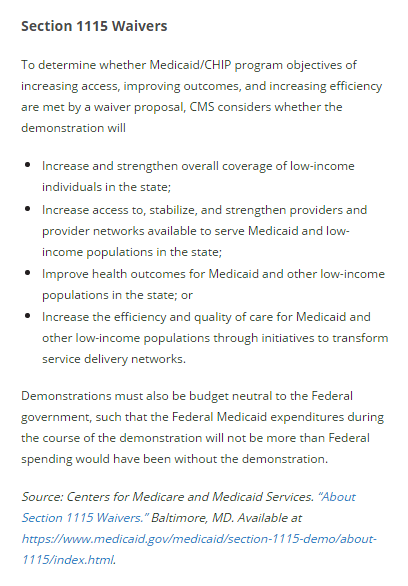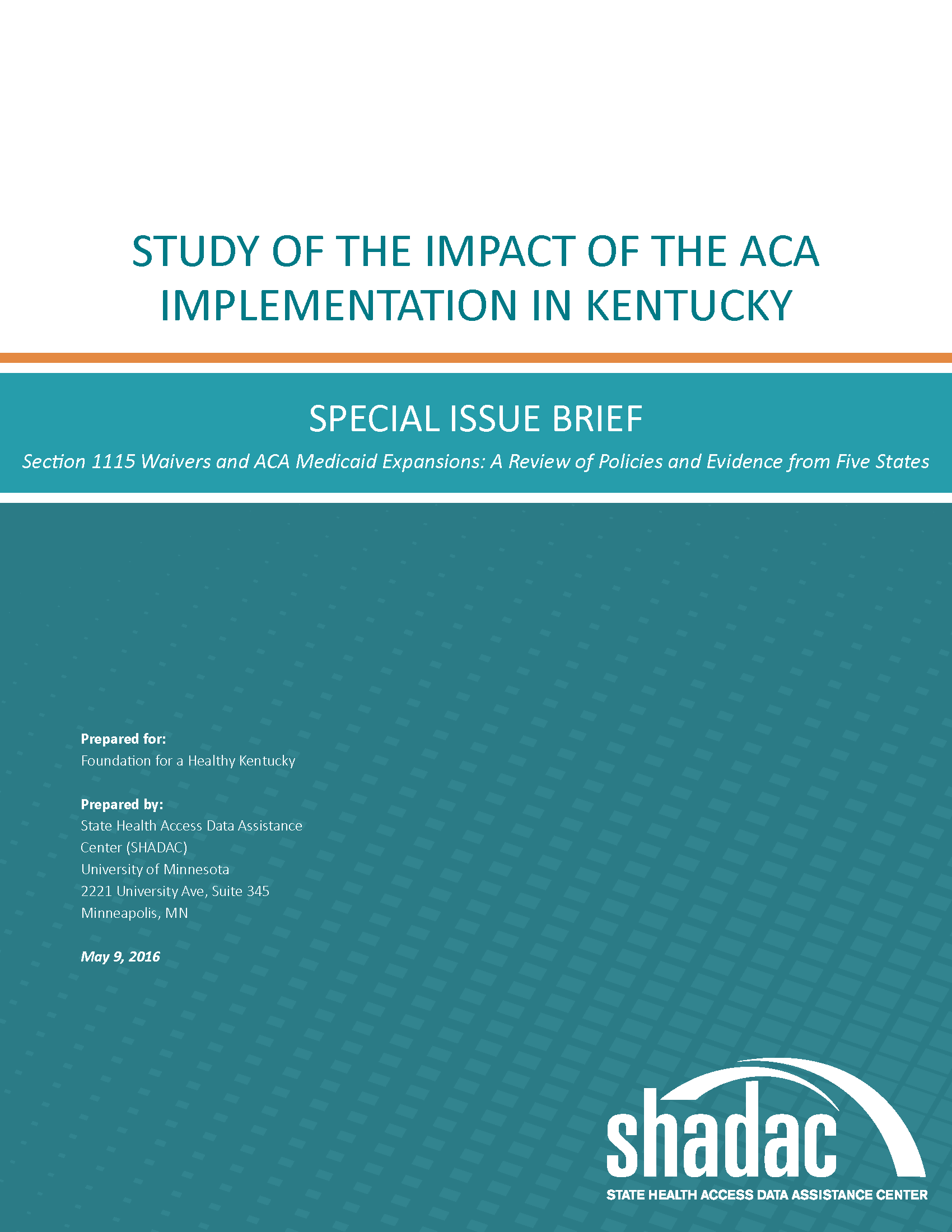Blog & News
How Do Section 1115 Medicaid Expansions Compare with Traditional Expansions? Considerations for Kentucky
December 19, 2016:The upcoming administration has indicated that it will be looking for ways to give states greater flexibility in how they design their Medicaid programs. One way to achieve this flexibility is through the use of Section 1115 demonstration waivers, through which the Centers for Medicare and Medicaid Services (CMS) can approve state-led experimental, pilot, or demonstration projects to evaluate program modifications such as eligibility expansion, provision of additional services not typically covered, or the use of innovative delivery systems that improve care, increase efficiency, and reduce costs. [1]
Shifting from Traditional Expansion to a Section 1115 Expansion: Uncharted Territory
Six of the 32 states that have expanded—or announced plans to expand—their Medicaid programs under the Affordable Care Act have done so using Section 1115 waivers. The State of Kentucky is among the 26 states that have implemented a traditional Medicaid expansion, but it has since announced plans to shift to an alternative 1115 waiver-based expansion. To date, only New Hampshire has transitioned from a traditional to a waiver-based expansion. And unlike Kentucky, that state’s traditional expansion was planned as a temporary step until the state implemented a waiver-based expansion.
A Closer Look at the Waiver Components under Discussion
SHADAC is currently conducting a study of the impact of ACA implementation in Kentucky that evaluates the ways in which the ACA impacts health care coverage, access, quality, cost, and health outcomes in the state.
Most recently, in light of Kentucky’s waiver proposal and in order to inform the discussion around the waiver, we have examined the main components of existing Medicaid expansion waivers in five states where the waivers most closely align with the Kentucky’s waiver discussion: Arkansas, Indiana, Iowa, Michigan, and Montana. The findings from this analysis are detailed in a special issue brief, “Section 1115 Waivers and ACA Medicaid Expansions: A Review of Policies and Evidence from Five States.” The waiver components explored in the brief include premium assistance, enrollee contributions, modified cost-sharing, healthy behavior incentives, and waiver of required benefits. In each case, arguments for and against the specific component as well as the relevant evidence. Overall, the results were mixed on the potential of the specific waiver activities to impact either access to health coverage and services or costs for newly eligible Medicaid beneficiaries.
View the full brief to access the detailed findings.
Waivers Increasingly Considered
The findings from this analysis having implications for other states moving forward with or considering Section 1115 waiver proposals. So far, in addition to Kentucky, Arizona and Ohio have announced intentions to transition from traditional to waiver-based expansions.
Learn more about SHADAC’s analysis of the impact of ACA implementation in Kentucky.
[1] Centers for Medicare and Medicaid Services. “About Section 1115 Waivers.” Baltimore, MD. Available at https://www.medicaid.gov/medicaid/section-1115-demo/about-1115/index.html.
Awarded Grant
Eligibility Criteria for HCBS and the Affordable Care Act (December 2016)
Principal Investigator: Brant Fries, PhD, University of Michigan
The goal of this study is to examine Medicaid long-term medical care eligibility criteria across states, and in particular, how the nursing facility level of care (LOC) criteria affect access to care through home and community-based services (HCBS). The researchers will compare LOC policies across four states that have adopted a standardized, comprehensive assessment instrument, the interRAI Home Care instrument. They will apply state-specific algorithms to data from a fifth state to measure each state’s relative degree of access to HBCS.
Grant Products & Publications
Using Standardized Data to Compare Access to Long-Term Services and Supports in Five U.S. States
(July 2017, Presentation at 21st IAGG World Congress of Gerontology & Geriatrics)
Awarded Grant
Evaluation of State Policies for Aligning Behavioral Health Coverage between Medicaid and State Health Insurance (December 2016)
Principal Investigator: Alexander Cowell, PhD, RTI International
The goal of this research is to inform state policy discussions around access to and continuity of behavioral health care in Medicaid and the exchanges for those who transition between these sources of coverage. The research team will analyze documents from state Medicaid plans and health insurance exchanges to assess the extent of alignment between Medicaid and private insurance in terms of the scope, level of coverage, and formulary design for behavioral health care. They will also assess whether alignment for behavioral health is different from that for general medical coverage.
Awarded Grant
State Benchmarking, Healthcare Outcomes, and Implications for People with Disabilities (December 2016)
Principal Investigator: Kathleen Thomas, PhD, University of North Carolina Chapel Hill
The goal of this study is to improve the physical and economic health of people with disabilities using evidence on state insurance benchmarking strategies that support improved access and quality healthcare for people with disabilities. The researchers will use data from the Health Reform Monitoring Survey (HRMS), a nationally representative online survey of approximately 7,400 non-elderly adults that is designed to allow rapid cycle monitoring of changes in coverage, health care access, and affordability under the ACA to accomplish the following:
- Combine state benchmarking strategies for Medicaid, expansion coverage, marketplace, and employer-sponsored plans with the HRMS.
- Test the impact of ACA insurance benchmarking reforms on access to care and employment for people with disabilities.
Awarded Grant
The Effect of State Minimum Wage Laws on Medicaid Expansion Outcomes (December 2016)
Principal Investigator: Christine Eibner, PhD, RAND Corporation
The goal of this study is to inform state-level policy discussions around whether minimum wage changes could have unintended consequences for workers’ health insurance access and to enable state policymakers to begin thinking about potential solutions. Over the past several years, there has been significant policy action regarding state minimum wage laws—with the federal minimum wage increasing by 40 percent between 2007 and 2010, and 15 states increasing their minimum wages above the federal requirement between 2010 and 2015. Higher minimum wages may affect employer-sponsored insurance enrollment if employers respond to wage increases by reducing benefit generosity, increasing employee contributions, or eliminating insurance entirely. Using data from the Current Population Survey, the researchers will estimate whether state minimum wage changes that occurred since 2007 were associated with reduced employer-sponsored insurance enrollment, and whether this effect was modified by Medicaid expansion.
Publications
The Effect of the 2014 Medicaid Expansion on Insurance Coverage for Newly Eligible Childless Adults
(2016, Report)
Do Minimum Wage Changes Affect Employer-Sponsored Insurance Coverage?
(June 2018, Presentation)












